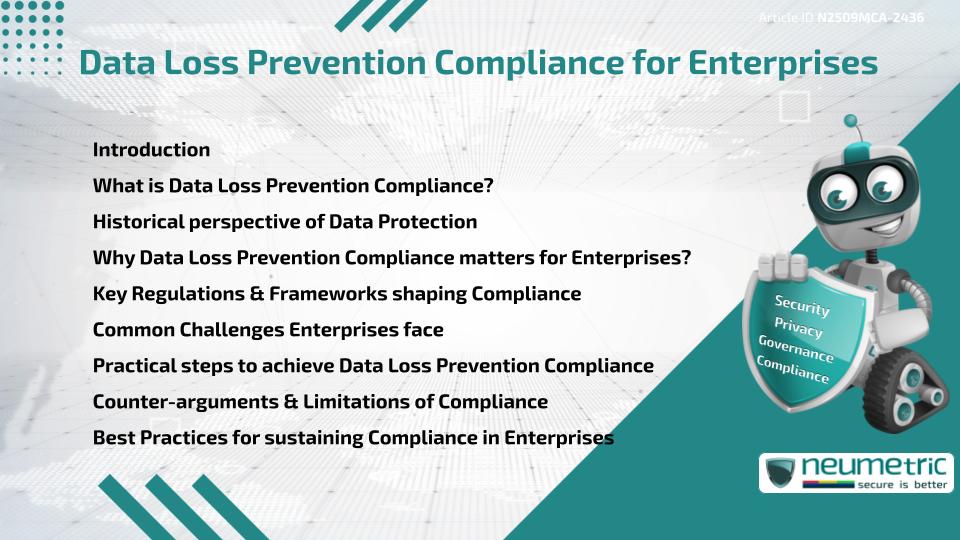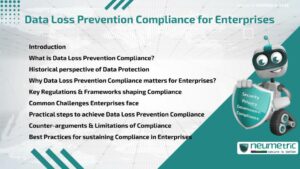Table of Contents
ToggleIntroduction
Data Loss Prevention Compliance refers to the Policies, Standards & Regulations that require enterprises to safeguard Sensitive Information from unauthorised access, sharing or leaks. It ensures that data-such as Financial Records, Personal Information & Intellectual Property-remains secure & is handled in line with Industry & Government requirements. For enterprises, failing to meet Data Loss Prevention Compliance can lead to fines, legal action & reputational harm. This article explores the meaning of Data Loss Prevention Compliance, its historical development, its importance for enterprises, key regulatory frameworks, challenges & practical steps to achieve Compliance.
What is Data Loss Prevention Compliance?
Data Loss Prevention Compliance is the alignment of enterprise security practices with Laws & Industry Standards that govern the protection of Sensitive Data. It requires enterprises to deploy Tools, Processes & Policies that detect & prevent data breaches, whether accidental or intentional.
An analogy is like securing valuables in a safe. The lock represents the technical measures, while Compliance ensures that the lock meets Legal & Regulatory expectations.
Historical perspective of Data Protection
The need for protecting Sensitive Information has existed for centuries, but the modern concept of Data Loss Prevention grew alongside digitisation in the late twentieth century. High-profile data breaches & stricter Privacy laws in the 2000s accelerated the adoption of Compliance-focused security programs.
Regulations like the General Data Protection Regulation [GDPR], the Health Insurance Portability & Accountability Act [HIPAA] & the Payment Card Industry Data Security Standard [PCI DSS] highlight how legal frameworks evolved to mandate the protection of personal & Financial data.
Why Data Loss Prevention Compliance matters for Enterprises?
Enterprises cannot afford to overlook Compliance due to the Risks involved:
- Legal requirements: Laws & Standards mandate strict handling of Sensitive Data.
- Customer Trust: Clients are more likely to work with enterprises that demonstrate data Responsibility.
- Financial protection: Compliance reduces the Risk of fines, lawsuits & breach-related costs.
- Reputation management: Enterprises that fail to protect data often suffer lasting brand damage.
- Operational continuity: Data loss incidents disrupt services & damage business resilience.
Data Loss Prevention Compliance is not just about avoiding penalties; it is about enabling long-term stability & growth.
Key Regulations & Frameworks shaping Compliance
Several major regulations & frameworks define the requirements enterprises must follow:
- GDPR (European Union): Protects Personal Data & enforces strict penalties for violations.
- HIPAA (United States): Requires the protection of Healthcare data.
- PCI DSS (Global): Governs security of payment card data.
- ISO/IEC 27001 (International): Provides a Framework for Information Security management systems.
- CCPA (California, United States): Grants Consumers rights over their Personal Information.
Enterprises must assess which regulations apply to them depending on their industry & regions of operation.
Common Challenges Enterprises face
Achieving Data Loss Prevention Compliance comes with significant challenges:
- Complexity of regulations: Different laws across jurisdictions may conflict.
- Volume of data: Enterprises generate & store enormous amounts of Sensitive Information.
- Human error: Employees remain one of the biggest Risks to Data Security.
- Integration issues: Legacy systems may not align with modern Compliance tools.
- High costs: Implementing Data Loss Prevention tools & processes requires Financial investment.
These challenges make Compliance an ongoing effort rather than a one-time task.
Practical steps to achieve Data Loss Prevention Compliance
Enterprises can take structured steps to build Compliance effectively:
- Identify Sensitive Data & classify it based on regulatory requirements.
- Deploy Data Loss Prevention tools that monitor, detect & block unauthorised transfers.
- Create clear Policies for handling Sensitive Information.
- Train Employees on Compliance responsibilities & secure data practices.
- Encrypt Sensitive Data both in transit & at rest.
- Conduct regular Audits to test Compliance readiness.
- Work with trusted Vendors that align with Compliance obligations.
Following these steps helps enterprises build resilience against both accidental & intentional data loss.
Counter-arguments & Limitations of Compliance
Some critics argue that Data Loss Prevention Compliance can become a “Checkbox Exercise” where enterprises meet the bare minimum instead of focusing on real security. Others highlight the high costs of Compliance & the difficulty smaller enterprises face in meeting strict standards.
While these concerns are valid, the consequences of non-Compliance legal fines, reputational damage & data breaches-are often far more costly & disruptive. Compliance should be seen as a foundation for security rather than the end goal.
Best Practices for sustaining Compliance in Enterprises
To ensure long-term Compliance, enterprises should:
- Foster a culture of Accountability across the workforce.
- Integrate Compliance into enterprise-wide Risk Management strategies.
- Leverage automation to monitor data flows & flag potential Risks.
- Update Compliance practices regularly to align with evolving laws.
- Collaborate with Regulators & Industry peers to share insights.
Making Compliance part of the enterprise culture ensures that it becomes second nature rather than a burden.
Conclusion
Data Loss Prevention Compliance is a critical requirement for enterprises managing Sensitive Information. It reduces Risks, protects Trust & ensures Legal & Financial safeguards. While challenges & criticisms exist, the benefits of Compliance far outweigh the costs. By adopting clear Policies, implementing strong Security Measures & fostering a culture of Responsibility, enterprises can meet Compliance Requirements & build long-term Resilience.
Takeaways
- Data Loss Prevention Compliance safeguards Sensitive Information against leaks & breaches.
- Regulations like GDPR, HIPAA & PCI DSS set Global Standards.
- Enterprises face challenges such as data volume, human error & high costs.
- Practical steps include Classification, Encryption, Training & regular Audits.
- Sustainable Compliance requires cultural integration & automation.
FAQ
What is Data Loss Prevention Compliance?
It is the alignment of enterprise practices with laws & standards requiring the protection of Sensitive Information.
Why is Data Loss Prevention Compliance important for enterprises?
It ensures Legal adherence, builds Customer Trust & protects against costly breaches.
Which regulations govern Data Loss Prevention Compliance?
Key regulations include GDPR, HIPAA, PCI DSS, ISO/IEC 27001 & CCPA.
What challenges make Compliance difficult?
Complex laws, high data volumes, human error, legacy systems & high implementation costs.
How can enterprises achieve Compliance?
By identifying Sensitive Data, deploying DLP tools, Encrypting data, Training staff & conducting Audits.
Does Compliance guarantee complete security?
No, Compliance reduces Risks but must be paired with strong technical & cultural Security Measures.
Can smaller enterprises achieve Compliance effectively?
Yes, by prioritising essential protections, leveraging scalable tools & seeking expert guidance.
Need help for Security, Privacy, Governance & VAPT?
Neumetric provides organisations the necessary help to achieve their Cybersecurity, Compliance, Governance, Privacy, Certifications & Pentesting needs.
Organisations & Businesses, specifically those which provide SaaS & AI Solutions in the Fintech, BFSI & other regulated sectors, usually need a Cybersecurity Partner for meeting & maintaining the ongoing Security & Privacy needs & requirements of their Enterprise Clients & Privacy conscious Customers.
SOC 2, ISO 27001, ISO 42001, NIST, HIPAA, HECVAT, EU GDPR are some of the Frameworks that are served by Fusion – a SaaS, multimodular, multitenant, centralised, automated, Cybersecurity & Compliance Management system.
Neumetric also provides Expert Services for technical security which covers VAPT for Web Applications, APIs, iOS & Android Mobile Apps, Security Testing for AWS & other Cloud Environments & Cloud Infrastructure & other similar scopes.
Reach out to us by Email or filling out the Contact Form…





